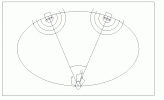Building a 2-way small active speaker with software crossover
1. Goal
To try software crossover method for a 2-way, active speaker
2. Software and instrumentation used
Per
@dualazmak hint, I will use
EKIO software crossover. It is very easy to use and it is free up to 2 IN/4 OUT channels.
For acoustical SW measurements, I am using REW software in combination with
VituixCad , VituixCad is also used for crossover and acoustical simulations.
For acoustical HW interface, I use
Behringer ECM8000 microphone with the calibration curve,
iConnectAudio4+ soundcard and
Roland Duo-Capture Ex soundcard.
As an audio amplifier, I use my
A250W4R or AIYIMA A07.
3. Speaker cabinet and drivers
The speaker cabinet used is made from 18mm MDF, dimensions 180 x 280 x 170 mm (w x h x d)
View attachment 313317
View attachment 313318
Woofer is a 4" Magnat MW 111 CP 754-I (no link unfortunately)
View attachment 313319
Tweeter is a
Monacor HT-88 horn loaded PA driver
View attachment 313320
4. Connectors
I need 4 wires to bring to the speaker, so the 4-way Speakon-like Cliff connector is used.
View attachment 313322
5. Crossover
I plan to use 48db/oct LR filters for the woofer and the tweeter. This will be completed with baffle step compensation shelf filter and necessary slope filter for the tweeter, with gain compensation between the low frequency and high frequency crossover sections. The goal is to get as flat on-axis response as will be possible. With the tweeter used, the useful HF range will be restricted to some 12kHz-15kHz, but I do not care, it fits to my hearing limit, being near to 70 years old

.
As already stated, the main goal is to try software crossover method. The passive R-L-C crossover with baffle compensation and air-core inductors would be that big that it would not fit inside the cabinet. And, the SW crossover is much more flexible for changes, and, is able to provide necessary filter slope to cut parasitic driver behaviour.
I am not posting the preliminary simulations, I will wait for first real measurements and post them then.
